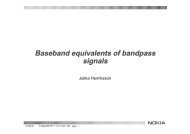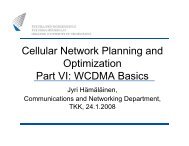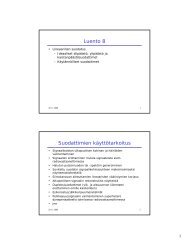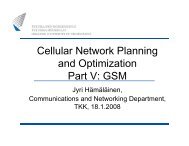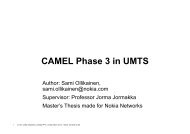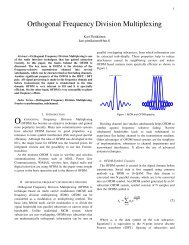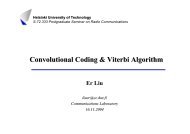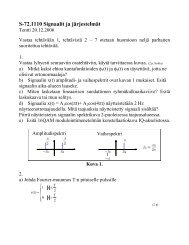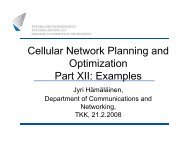Spread Spectrum Principles and Methods
Spread Spectrum Principles and Methods
Spread Spectrum Principles and Methods
Create successful ePaper yourself
Turn your PDF publications into a flip-book with our unique Google optimized e-Paper software.
S-72.333<br />
Post-graduate Course in Radio Communications<br />
2001-2002<br />
<strong>Spread</strong> <strong>Spectrum</strong> <strong>Principles</strong> <strong>and</strong> <strong>Methods</strong><br />
Jarmo Oksa<br />
Email: jarmo.oksa@nokia.com<br />
Date: 12.2.2002
1. BASIC PRINCIPLES OF SPREAD SPECTRUM...........................................................................3<br />
1.1 DIRECT SEQUENCE (DS) SPREAD SPECTRUM...................................................................................7<br />
1.1.1 Complex spreading.................................................................................................................7<br />
1.1.2 Dual channel quaternary spreading.........................................................................................8<br />
1.1.3 Balanced quaternary spreading...............................................................................................8<br />
1.1.4 Simple binary spreading .........................................................................................................9<br />
1.2 FREQUENCY HOP (FH) SPREAD SPECTRUM .................................................................................10<br />
2. SPREADING SEQUENCES ............................................................................................................12<br />
2.1 SPREADING WAVEFORMS .............................................................................................................15<br />
2.2 M-SEQUENCES .............................................................................................................................15<br />
2.3 GOLD SEQUENCES.........................................................................................................................18<br />
2.4 KASAMI SEQUENCES ....................................................................................................................19<br />
2.5 BARKER SEQUENCES....................................................................................................................20<br />
2.6 WALSH-HADAMARD SEQUENCES.................................................................................................20<br />
3. POWER SPECTRAL DENSITY OF SPREAD SPECTRUM SIGNALS....................................21<br />
REFERENCES......................................................................................................................................23<br />
2
1. BASIC PRINCIPLES OF SPREAD SPECTRUM<br />
Since 1940's spread spectrum systems were developed for antijam <strong>and</strong> low probability of<br />
intercept (LPI) applications [10] by spreading the signal over a large frequency b<strong>and</strong> <strong>and</strong><br />
transmitting it with a low power per unit b<strong>and</strong>width. In the antijam systems spectral<br />
spreading secures the signal against narrowb<strong>and</strong> interferers (Figure 1, [4]) <strong>and</strong> in the LPI<br />
systems it to makes the detection as difficult as possible for an unwanted interceptor by<br />
hiding the signal in the noise.<br />
Figure 1 : Narrowb<strong>and</strong> interference rejection ([4] : Figure 5.17)<br />
In the spread spectrum systems instead of allocating disjoint frequency channels or time<br />
slots for different users the simultaneous users are on the same frequency b<strong>and</strong>. The<br />
fundamental problem of spread spectrum in a multiple access communication application<br />
(code division multiple access, CDMA) is that each user causes multiple access<br />
interference (MAI) affecting all the other users. When the spectral efficiency of the<br />
different multiple access methods was calculated by taking into account the original<br />
signal b<strong>and</strong>width, the guard b<strong>and</strong>s for FDMA, guard time for TDMA <strong>and</strong> MAI for<br />
CDMA but not the channel properties the following results were obtained : (Table 1) [4].<br />
3
Table 1 : Summary of multiple access technologies ([4] Dixon, <strong>Spread</strong> Systems with<br />
Commercial Applications : Table 12.2 )<br />
Lower level of spectral efficiency was obtained for CDMA. In the early multiple access<br />
systems CDMA did not give clear advantage over TDMA/FDMA. The narrowb<strong>and</strong><br />
methods FDMA <strong>and</strong> TDMA are more sensitive to channel impairments but unless they<br />
are serious enough MAI is the dominating source of errors. Error probability calculations<br />
based on MAI modeled as AWGN can be found in [2] <strong>and</strong> [3].<br />
However, recently spread spectrum technology has become a viable alternative for<br />
cellular systems. The advantages of using spread spectrum for cellular applications<br />
include: inherent multipath diversity (large b<strong>and</strong>width allows using many multipath<br />
components in the RAKE receiver), soft capacity (by exploiting the capacity without<br />
reallocating channels), soft h<strong>and</strong> off capability, improved spectral efficiency (no need for<br />
the frequency reuse distance between cells <strong>and</strong> guard b<strong>and</strong>s of adjacent frequencies)<br />
narrow b<strong>and</strong> interference rejection (Figure 1, [4]) <strong>and</strong> inherent message privacy.[1] The<br />
main disadvantage of spread spectrum is caused by MAI: the detected signals must be<br />
controlled to have equal power to avoid the near-far effect.<br />
In a spread spectrum system the data symbols x = {x n } are modulated onto a carrier by<br />
using a spreading sequence (signature sequence, spreading code) a = {a k } that is different<br />
for each user. This sequence spreads the transmitted signal b<strong>and</strong>width to be much larger<br />
than the data signal b<strong>and</strong>width. The spread spectrum system contains the following<br />
operations : data modulation of bits to symbols, spreading (b<strong>and</strong>width expansion) <strong>and</strong><br />
carrier modulation [5] :<br />
4
Transmitter :<br />
Receiver :<br />
<strong>Spread</strong>ing can be performed either on the baseb<strong>and</strong> or on the carrier frequency:<br />
Data<br />
bits<br />
Data<br />
modulation<br />
Data<br />
symbol<br />
sequence<br />
x n<br />
<strong>Spread</strong>ing<br />
Passb<strong>and</strong> signal :<br />
Re{a(t)⋅x(t)⋅e j2πft }<br />
Despreading<br />
Data<br />
symbol<br />
sequence<br />
x n<br />
Data<br />
demodulation<br />
Data<br />
bits<br />
<strong>Spread</strong>ing<br />
sequence a n<br />
<strong>Spread</strong>ing<br />
sequence a n<br />
Possible places for carrier modulation <strong>and</strong> demodulation<br />
Figure 2<br />
Because in general the data <strong>and</strong> spreading sequences are complex the transmitted signal<br />
can be modeled as the real part of the product of three complex signals :<br />
{ e j 2π f t c<br />
a(<br />
t)<br />
⋅ x(<br />
t)<br />
}<br />
s( t)<br />
= Re ⋅<br />
,where the part a(t)⋅x(t) that is used to modulate the carrier is called the complex envelope<br />
The complexity is implemented by the phase-shifted I- <strong>and</strong> Q-carriers. (The signals with<br />
real <strong>and</strong> imaginary parts are drawn by double lines in Figure 2).<br />
5
When spreading is performed in time domain, i.e. the chips of the signature sequence are<br />
placed in different chip periods T c the spread spectrum method is :<br />
1. Direct sequence CDMA (DS-CDMA) when each symbol x n is spread into a sequence of<br />
chips on a single carrier.<br />
Thespreadingwaveforma(<br />
t)<br />
= A⋅<br />
a<br />
are used to modulatea singlecarrier f<br />
, where<br />
h ( t − kT ) <strong>and</strong> data waveform<br />
x(<br />
t)<br />
= A⋅<br />
x u<br />
( t − nT)<br />
withthebaseb<strong>and</strong>complex<br />
evelope s~ ( t)<br />
= a(<br />
t)<br />
⋅ x(<br />
t)<br />
h ( t) <strong>and</strong> u(<br />
t) are therealchip<strong>and</strong> bit amplitudeshapingfunctions<br />
c<br />
k<br />
c<br />
k<br />
c<br />
c<br />
n<br />
n<br />
T<br />
Data symbol<br />
Sprading<br />
sequence :<br />
1 1-1 1-1 1-1<br />
t<br />
t<br />
2. Frequency hopping CDMA (FH-CDMA) when each data symbol x n is spread into a<br />
sequence of chips on different frequence shifts f k of the central carrier frequency f c . It is<br />
modulated by the complex envelope<br />
~ j f<br />
k<br />
t<br />
s (<br />
2π<br />
t)<br />
= x(<br />
t)<br />
⋅ h ( t − kT ) ⋅ e<br />
Data symbol<br />
k<br />
c<br />
c<br />
t<br />
<strong>Spread</strong>ing<br />
sequence :<br />
f 1 f 2 f 3 f 4 f 4 f 5 f 6<br />
1 1-1 1-1 1<br />
t<br />
3. Time hopping CDMA (TH-CDMA) when the chips a k are used to modulate a single carrier<br />
by placing one chip inside the symbol frame T at a different time slot T c for each sequential<br />
symbol.<br />
Data symbols<br />
t<br />
<strong>Spread</strong>ing<br />
sequence :<br />
t<br />
When the spreading modulation is performed in the frequency domain the chips of the<br />
signature sequence are used to modulate simultaneously different orthogonal subcarriers.<br />
This spectrum method is called multicarrier CDMA (MC-CDMA). Instead of modulating<br />
each sequential symbol on a different subcarrier (typically in OFDM) the same symbol x n<br />
is in MC-CDMA used to modulate all the subcarriers f k = k⋅∆f by using a different chip<br />
values a k for each subcarrier.<br />
6
However, OFDM can be used together with MC-CDMA by converting a block of serial<br />
data symbols into a block of parallel data symbols <strong>and</strong> modulating each parallel symbol<br />
on a different set orthogonal subcarriers.<br />
Data<br />
sequence<br />
x 1 …x N<br />
Serial<br />
Parallel<br />
Converter<br />
x 1<br />
<strong>Spread</strong>ing<br />
modulator<br />
x 1 a 1 e j2π∆ft<br />
x 1 a K e j2πK∆ft<br />
X 2<br />
x N<br />
Figure 3 [6]<br />
1.1 DIRECT SEQUENCE (DS) SPREAD SPECTRUM<br />
In a DS spread spectrum system (Data modulated carrier is modulated directly by a code<br />
sequence) the ratio of the symbol <strong>and</strong> chip periods is called the processing gain G = T / T c<br />
The temporal length of one code period of a short code sequence is equal to the symbol<br />
period (G = N, T =N⋅T c ). The code period of a long code sequence contains several<br />
symbol periods (G
Figure 4 : Complex spreading ([1] : Figure 9.2)<br />
1.1.2 Dual channel quaternary spreading :<br />
When the spreading sequence a(t) is real the I- <strong>and</strong> Q-channels have independent<br />
spreading sequences a I (t) <strong>and</strong> a Q (t). The data sequence x(t) can be QPSK modulated or<br />
consist of independent BPSK modulated data sequences x I (t) or x Q (t). When BPSK data<br />
modulation is used x(t) is real <strong>and</strong> x I (t) <strong>and</strong> x Q (t)are independent data sequences<br />
a(t)=a I (t) <strong>and</strong> a Q (t)<br />
(real sequence)<br />
x(t)= x I (t) +j⋅ x Q (t) or x(t)= x I (t) <strong>and</strong> x Q (t) (complex or 2 real sequences)<br />
a I,Q = {a k : a k ∈{±1,}} , x I,Q ={x n :x n ∈{±1/√2,±j /√2},<br />
This can be implemented by the dual channel quaternary spreading circuit :<br />
Figure 5 : Dual channel quaternary spreading<br />
([1] : Figure 9.3)<br />
1.1.3 Balanced quaternary spreading :<br />
When the spreading sequence is real a(t) having independent sequences a I (t) <strong>and</strong> a Q (t)<br />
for the I- <strong>and</strong> Q-carrier <strong>and</strong> only one real BPSK data sequence x(t) is used<br />
a(t)=a I (t) <strong>and</strong> a Q (t)<br />
(real sequences)<br />
x(t)<br />
(one real data sequence)<br />
a I,Q = {a k : a k ∈{±1,}} , x={x n :x n ∈{±1}<br />
8
This can be implemented by the balanced quaternary spreading circuit :<br />
Figure 6 :Balanced quaternary<br />
spreading ([1] : Figure 9.4b)<br />
1.1.4. Simple binary spreading :<br />
One real BPSK modulated data sequence can be also spread to a single carrier by the<br />
simple binary spreading :<br />
a(t)<br />
(one real spreading sequence)<br />
x(t)<br />
(one real data sequence)<br />
a = {a k : a k ∈{±1,}} , x={x n :x n ∈{±1}:<br />
Figure 7 : Simple binary spreading<br />
([1] : Figure 9.4a)<br />
The DS spread spectrum receiver performs the following functions: code synchronization<br />
with the incoming sequence, phase synchronization with the incoming phase in the case<br />
of coherent detection, despreading <strong>and</strong> filtering the signal <strong>and</strong> detecting the data. Code<br />
<strong>and</strong> phase synchronization consist of acquisition <strong>and</strong> tracking operations.<br />
The received signal can be despread by using a matched filter or correlator. Matched<br />
filters are used with incoherent detection <strong>and</strong> for code acquisition with the coherent<br />
detection.<br />
9
Figure 8 : Simplified DS/QPSK system ([1] : Figure 9.1)<br />
The bit error probability of DS/QPSK with Gray coding given by a ML receiver in an<br />
AWGN channel is identical to QPSK [1]:<br />
P<br />
e<br />
( 2⋅<br />
E / N )<br />
= Q<br />
, which is identical to conventional coherent QPSK.<br />
b<br />
0<br />
<strong>Spread</strong>ing <strong>and</strong> despreading do not improve P e in an AWGN-channel because b<strong>and</strong>width<br />
expansion is independent of data <strong>and</strong> spreading does not affect the spectral <strong>and</strong><br />
probability density functions of AWG-noise [1] ,[7].<br />
DS spread spectrum system with pseudonoise sequencies is an averaging type system.<br />
Multiple access interference from other users is reduced by averaging it.<br />
1.2 FREQUENCY HOP (FH) SPREAD SPECTRUM<br />
In frequency hopping spread spectrum systems the carrier frequency hops throughout a<br />
finite set of frequencies during the code period. FH spread spectrum system is an<br />
avoidance type system in which interference is reduced by avoiding same frequencies.<br />
There are two basic types of FH spread spectrum: slow frequency hopping (SFH) <strong>and</strong> fast<br />
frequency hopping (FFH). SFH systems transmit one or more data symbols per hop. FFH<br />
systems transmit the same data symbol on multiple sequential hop frequencies.<br />
10
Figure 9 : Simplified FH system operating on an AWGN channel ([1] : Figure 9.5)<br />
When M-ary frequency shift keying (MFSK) is used as data modulation ∆f is the<br />
frequency separation between symbols x k . The hopping frequencies f h are frequency<br />
shifts relative to the center frequency determined by the symbol x k . The complex envelope<br />
for slow frequency hopping is ([1]: (9.17)) :<br />
~ L<br />
jx π∆f<br />
⋅t+<br />
2 π f ⋅t<br />
nL+<br />
i<br />
n<br />
s ( t)<br />
= A e<br />
u ( t − ( nL + i)<br />
T )<br />
n i=<br />
1<br />
The complex envelope for fast frequency hopping is ([1]: (9.18)) :<br />
~ L<br />
jx π∆ f ⋅t+<br />
2 π f<br />
+<br />
n<br />
nL i<br />
s ( t)<br />
= A e<br />
u ( t − ( nL + i)<br />
T / L)<br />
n i=<br />
1<br />
⋅t<br />
T<br />
T<br />
The inner sum indexes for SFH the data symbols <strong>and</strong> for FFH the hopping frequencies.<br />
The FH spread spectrum system may use coherent or incoherent detection but especially<br />
for FFH the coherent frequency synthesizer is difficult to implement.<br />
11
2. SPREADING SEQUENCES<br />
The spreading sequences can be classified as orthogonal sequences <strong>and</strong> pseudonoise (PN)<br />
sequences. The cross correlation of the orthogonal sequences is zero <strong>and</strong> so MAI from<br />
other users is cancelled. Orthogonal sequences are used in synchronous CDMA systems<br />
because the cross correlation function varies remarkably as a function of the time shift of<br />
the sequences.<br />
The pseudonoise (PN) sequences have auto-correlation function that is similar to white<br />
Gaussian noise. The received sequences from other users are also noise-like signals. MAI<br />
from other users is distributed evenly in time <strong>and</strong> between the interfering users. This<br />
allows asynchronous operation. They are chosen to have three desirable attributes [1]:<br />
1) Each element of the sequence (1,0 or +1,-1) occurs with equal frequency,<br />
2) The auto-correlation has small off-peak values to allow rapid sequence acquisition <strong>and</strong><br />
3) Cross-correlation is small at all delays.<br />
However, the attributes 2) <strong>and</strong> 3) are difficult to achieve simultaneously. Designing the<br />
sequences to have low cross correlation reduces the r<strong>and</strong>omness of the sequences <strong>and</strong><br />
increases the off-peak values of the auto-correlation function. [8]<br />
<strong>Spread</strong>ing sequences are often characterized in terms of their discrete-time correlation<br />
properties with the time shift n. When short codes are used the auto- <strong>and</strong> cross-correlation<br />
are calculated over a full sequence period N. When they are calculated periodically the<br />
values of sequential data symbols are ignored.<br />
The periodic auto-correlation of the k-th complex spreading sequence a (k) over a a full<br />
period N is ([1])<br />
φ<br />
k,<br />
k<br />
1<br />
( n)<br />
=<br />
2N<br />
N −1<br />
<br />
i=<br />
0<br />
a<br />
*<br />
( k ) ( k )<br />
i ai+<br />
n<br />
<strong>and</strong> the periodic cross-correlation over a full period N between the k-th <strong>and</strong> m-th sequences<br />
a (k) <strong>and</strong> a (m) is ([1])<br />
φ<br />
k,<br />
m<br />
1<br />
( n)<br />
=<br />
2N<br />
N −1<br />
<br />
i=<br />
0<br />
a<br />
( k )<br />
i<br />
a<br />
( m)<br />
i+<br />
n<br />
*<br />
The aperiodic auto-correlation over the full period N of the sequence a (k) calculates only<br />
the overlapping part of the sequences ([1]).<br />
12
φ<br />
a<br />
k,<br />
k<br />
1<br />
2N<br />
1<br />
( n)<br />
= <br />
2N<br />
<br />
<br />
N −n<br />
<br />
i=<br />
1<br />
N + n<br />
<br />
i=<br />
1<br />
a<br />
a<br />
0<br />
( k )<br />
i+<br />
n<br />
( k )<br />
i<br />
a<br />
a<br />
( k )<br />
i<br />
( k )<br />
i−n<br />
*<br />
*<br />
, 0 ≤ n ≤ N −1<br />
, − N + 1 ≤ n ≤ 0<br />
, n ≥ N<br />
Similar equations are obtained for the aperiodic cross-correlation of sequences a (k) <strong>and</strong><br />
a (m) over a full period N.<br />
Periodic cross-correlation over full<br />
period :<br />
a k :<br />
N=T<br />
a m :<br />
Aperiodic cross-correlation<br />
over full period:<br />
a k :<br />
a m :<br />
kT<br />
(k+1)T<br />
n>0<br />
t<br />
kT<br />
(k+1)T<br />
t<br />
Figure 10 : Periodic <strong>and</strong> aperiodic full period auto- <strong>and</strong> cross-correlations<br />
a<br />
φk, k ( n)<br />
= φ k,<br />
k ( n)<br />
+ φ k,<br />
k ( n − N )<br />
a<br />
[] 2<br />
By using the aperiodic auto-correlation the effect of different consequent symbols can be<br />
taken into account [2]:<br />
a<br />
a<br />
φ , ( n,<br />
b−1,<br />
b0<br />
) = b0<br />
⋅φ<br />
k,<br />
k ( n)<br />
+ b−1<br />
⋅φ<br />
k,<br />
k ( n − N ) , b−1<br />
<strong>and</strong> b0<br />
are consequent symbols ( + 1,-1)<br />
k k<br />
When long codes are used the partial period auto- <strong>and</strong> cross-correlations are calculated<br />
over the bit period T=G⋅T c instead of the whole sequence period N ([1]).<br />
φ<br />
φ<br />
p<br />
k,<br />
k<br />
p<br />
k,<br />
m<br />
1<br />
( n)<br />
=<br />
2G<br />
G −1<br />
a<br />
i = 0<br />
1<br />
( n)<br />
=<br />
2G<br />
G−1<br />
<br />
i=<br />
0<br />
*<br />
( k ) ( k )<br />
i ai<br />
+ n<br />
a<br />
( k )<br />
i<br />
a<br />
( m)<br />
i+<br />
n<br />
*<br />
13
Periodic correlation over<br />
partial period:<br />
a k :<br />
a m :<br />
Aperiodic correlation over<br />
partial period:<br />
a k :<br />
a m :<br />
kT<br />
(k+1)T<br />
t<br />
Symbol period<br />
t<br />
Sequence period<br />
Figure 11 : Periodic <strong>and</strong> aperiodic partial period auto- <strong>and</strong> cross-correlations<br />
The partial period correlations are not only a function of the delay n, but also depend<br />
upon the point in the sequence where the summation actually starts. They are difficult to<br />
derive analytically. Therefore, statistical auto- <strong>and</strong> cross-correlations are used assuming<br />
that the sequences with elements {±1,±j} are r<strong>and</strong>omly generated.<br />
The mean <strong>and</strong> variance of the partial period autocorrelation (periodic) are ([1])<br />
G−<br />
k m<br />
[ k k n ] = E[ ai<br />
ai<br />
+ n ]<br />
p 1 1<br />
*<br />
( ) ( )<br />
φ , ( )<br />
( n)<br />
= E<br />
= n,<br />
2G<br />
µ φ<br />
δ<br />
p<br />
k , k<br />
N<br />
i=<br />
0<br />
2 p<br />
2<br />
2<br />
1 0 . n = N<br />
p<br />
σ φ k , k ( n)<br />
= E φ k,<br />
k ( n)<br />
− µ φ k k n = ( − n N ) = <br />
<br />
p<br />
, ( ) 1 δ , <br />
G 1/<br />
G , n ≠ N<br />
1.<br />
n = N<br />
= <br />
0 , n ≠ N<br />
The mean <strong>and</strong> variance of the partial period cross-correlation (periodic) are ([1])<br />
[ φ<br />
p k m(<br />
n)<br />
] = 0 , ∀n<br />
µ φ m( n)<br />
= E<br />
p<br />
,<br />
2<br />
p<br />
2<br />
n E<br />
<br />
n<br />
2<br />
σ φ p<br />
k , m ( ) = φ k,<br />
m(<br />
) − µ φ<br />
p<br />
k , m ( n)<br />
= 1/ G , ∀n<br />
<br />
14
2.1 SPREADING WAVEFORMS<br />
In asynchronous systems the auto- <strong>and</strong> cross-correlation for the continuous-time waveforms<br />
depend also on the amount of overlapping δ of the chip waveforms :<br />
h c (t)<br />
0<br />
T c<br />
c k<br />
t'<br />
c k<br />
t'<br />
δ<br />
l<br />
Figure 12 : Chip overlapping<br />
The continuous-time periodic cross-correlation over a full period between the spreading<br />
waveforms a (k) (t) <strong>and</strong> a (m) (t) depends both on the time shift between the sequences l<br />
(earlier n) <strong>and</strong> the chip overlapping time shift δ ([1]) :<br />
R<br />
k,<br />
m<br />
1<br />
T<br />
( k)<br />
( m)<br />
( τ ) = a ( t)<br />
a ( t + τ ) dt<br />
T 0<br />
= φ ( )<br />
R ( δ ) + φ ( + 1) Rˆ<br />
k,<br />
m<br />
h<br />
k,<br />
m<br />
h<br />
( δ )<br />
For rectangular chip waveform h c (t) = u Tc (t) :<br />
δ <br />
Rk<br />
, m( ) φk,<br />
m(<br />
) 1<br />
− + φk,<br />
m(<br />
+ 1)<br />
Tc<br />
<br />
T<br />
, τ = T<br />
, R<br />
h<br />
c<br />
( δ ) , Rˆ<br />
+ δ<br />
δ<br />
τ , τ = T<br />
+ δ<br />
= c<br />
c<br />
h<br />
( δ ) : chip waveformcorrelations<br />
The maximum auto- <strong>and</strong> cross-correlations are obtained by the chip-synchronous<br />
approximation (δ=0) :<br />
Rk<br />
, k ( τ ) ≤ φk,<br />
k ( )<br />
, Rk,<br />
m(<br />
τ ) ≤ φk,<br />
m(<br />
)<br />
The partial period auto- <strong>and</strong> cross correlations are statistical funtions.<br />
2.2 M-SEQUENCES<br />
A widely used type of PN sequences are the maximum-length shift-register sequences<br />
(LFSR), m-sequences. Each sequence is generated by a separate LFSR that has m stages.<br />
The period of the sequence (sequence length) is N = 2 m –1. They are the longest<br />
sequences that can be generated by an LFSR for a given m. [1]<br />
15
Figure 13 : m-sequence generator ([1] : Figure 9.6)<br />
The multipliers p i ∈ {0,1} <strong>and</strong> ⊕ denotes modulo 2 addition . The elements (chips) of<br />
the sequence a i ∈ {0,1} are mapped to {+1,-1} for bipolar coding. The sequence a(k) has<br />
2 m-1 ones <strong>and</strong> 2 m-1 –1 zeros.<br />
The feedback polynomial is a primitive polynomial of degree m over GF(2) [1] :<br />
P(x) = 1 ⊕ p 1 x ⊕ p 2 x 2 ⊕ p 3 x 3 ⊕ … ⊕ p m-1 x m-1 ⊕ x m<br />
An m-sequence has almost an ideal full period autocorrelation :<br />
1<br />
, n = N<br />
φ( n)<br />
= <br />
−1/<br />
N , n ≠ N<br />
The full period auto-correlation function for continuous time sequence waveforms a (k) (t)<br />
when the rectangular chip shaping function h c (t) = u Tc (t) is used is :<br />
R<br />
δ <br />
δ<br />
τ ) = φk,<br />
k ( ) 1<br />
− + φk<br />
k ( + 1) , τ = Tc<br />
+ δ<br />
Tc<br />
Tc<br />
k,<br />
k ( ,<br />
Figure 14 : Typical full period autocorrelation function of<br />
an m-sequence spreading waveform ([1] : Figure 9.7)<br />
16
However, only for certain values of m there exist some pairs of m-sequences with low full<br />
period cross-correlation. When the average full period cross-correlation between<br />
sequences a (k) <strong>and</strong> a (m) is calculated for different shifts n of the sequences:<br />
θ =<br />
N<br />
1 N −1<br />
φ<br />
n=<br />
0<br />
( )<br />
k, m n<br />
the value of θ varies much depending on the particular pair of m-sequences that are<br />
selected <strong>and</strong> the worst θ-values are great.<br />
Tabel 2 : Best <strong>and</strong> worst case average cross-correlations for m-sequences<br />
([1]: Table 9.1)<br />
Figure 15 : Cross-correlation function of typical m-<br />
sequences ([4])<br />
17
2.3 GOLD SEQUENCES<br />
A set Gold sequences consist of 2 m+1 sequences having the period N = 2 m –1 that are<br />
generated by a preferred pair of m-sequences. This set contains both the preferred pair<br />
(a (1) ,a (2) ) <strong>and</strong> the 2 m -1 new generated sequences. The sequences are generated by taking a<br />
modulo-2 sum of a (1) with the 2 m-1 cyclically shifted versions of a (2) or vice versa.<br />
Figure 16 : A Gold sequence generator with p 1 (x)= 1+x 2 +x 5 <strong>and</strong> p 2 (x)= 1+x+x 2 +x 4 +x 5<br />
This sequence generator can produce 32 Gold sequences of length 31. ([1]: Figure 9.8)<br />
Because the Gold sequences are not maximal length sequences (except a (1) <strong>and</strong> a (2) ) the<br />
auto-correlation function is not 2-valued. Both the cross-correlation <strong>and</strong> off-peak autocorrelation<br />
functions are 3-valued : {-1, -t(m), t(m)-2}, where<br />
2<br />
t(<br />
m)<br />
= (<br />
2<br />
( m+<br />
1) / 2+<br />
1<br />
m+<br />
2) / 2<br />
+ 1<br />
, when<br />
, when<br />
m is odd<br />
m is even<br />
So both the cross correlation <strong>and</strong> off-peak auto-correlation functions are upper bounded<br />
by t(m) :<br />
18
Table 3 : Peak cross correlation of m-sequences <strong>and</strong> Gold-sequences<br />
([1] : Table 9.2)<br />
2.4 KASAMI SEQUENCES<br />
The small set of Kasami sequences consists 2 m/2 sequences having the period N = 2 m –1.<br />
This set is generated in a way similar to the Gold sequences by using a pair of a long<br />
sequence a (1) <strong>and</strong> a short sequence a (2) that are m-sequences. This set contains both the<br />
long sequence a (1) <strong>and</strong> the 2 m/2 -1 new generated sequences. The sequences are generated<br />
by taking a modulo-2 sum of a (1) with all the 2 m/2 -1 cyclic shifts of a (2) .<br />
Figure 17 : A Kasami sequence generator with p 1 (x)= 1+x+x 6 <strong>and</strong><br />
p 2 (x)= 1+x+x 3 . This sequence generator can produce 8 Kasami<br />
sequences of length 63. ([1]: Figure 9.9)<br />
19
Like for Gold sequences the cross-correlation <strong>and</strong> off-peak auto-correlation functions are<br />
3-valued. The possible values are : {-1, -s (m), s(m)-2}, where<br />
/ 2<br />
t(<br />
m)<br />
= 2<br />
m + 1<br />
The upper bound s(m) for the cross correlation <strong>and</strong> off-peak auto-correlation functions is<br />
reduced to half compared with the Gold sequences of the same length.<br />
The large set of Kasami sequences contains also Gold sequences <strong>and</strong> hence the crosscorrelation<br />
<strong>and</strong> off-peak autocorrelation values are on the average higher than in the small<br />
set of Kasami sequences.<br />
2.5 BARKER SEQUENCES<br />
The Barker sequences are aperiodic sequences (finite length sequences). Their crosscorrelation<br />
<strong>and</strong> off-peak auto-correlation values are limited by 1/N but they are known<br />
only for code lengths N=2,3,4,5,7,11. Because the Barker sequences are short <strong>and</strong> their<br />
number is limited they are used for special purpose systems (as for initial synchronization<br />
<strong>and</strong> wireless LANs). 1<br />
,n = 0<br />
φ<br />
a<br />
k<br />
, k<br />
<br />
( n)<br />
= <br />
0,<br />
<br />
1<br />
N<br />
1<br />
or −<br />
N<br />
,n ≠ 0<br />
2.6 WALSH-HADAMARD SEQUENCES<br />
The Walsh-Hadamard sequences are orthogonal sequences. They are the rows of the<br />
Hadamard matrix that is obtained by the recursion :<br />
H<br />
M H M <br />
1<br />
1 <br />
H 2 M = <br />
starting from H 2 =<br />
H<br />
M − H<br />
<br />
M <br />
1<br />
−1<br />
<br />
The Walsh-Hadamard sequences can be used either to spread orthogonally (orthogonal<br />
CDMA) the signals of the different users or for M-ary orthogonal coding the different<br />
symbols.<br />
If orthogonal sequences are used for different users accurate synchronization is needed<br />
because the orthogonal sequences have for non-zero time shifts large cross-correlation<br />
<strong>and</strong> off-peak auto-correlation values.<br />
If orthogonal symbols are used k=log 2 M bits are used to encode one of the orthogonal<br />
symbols. The user signals are spread by different pseudonoise sequences.<br />
20
3. POWER SPECTRAL DENSITY OF DS SPREAD SPECTRUM<br />
SIGNALS<br />
For uncorrelated zero-mean data symbols the power spectral density of the baseb<strong>and</strong><br />
complex envelope is ([1] : 4.206)<br />
2<br />
A 2<br />
S~ s~<br />
s ( f ) = σ x H a ( f )<br />
T<br />
2<br />
([]<br />
1 : 9.58)<br />
,where h a (t) is the amplitude shaping waveform determined by the spreading sequence a k<br />
<strong>and</strong> the chip pulse waveform h c (t)<br />
h ( t)<br />
a<br />
H<br />
a<br />
N 1<br />
= <br />
− ak<br />
c<br />
k = 0<br />
2<br />
c<br />
h ( t − kT )<br />
c<br />
([]<br />
1 : 9.59)<br />
2<br />
( f ) = H ( f ) ⋅ N ⋅Φ<br />
( f )<br />
([]<br />
1 : 9.62)<br />
2 k,<br />
k<br />
,where Φ k,k (f) is the discrete Fourier transform of the aperiodic autocorrelation function<br />
φ k,k (n) of the spreading sequence a k .<br />
The power spectral density depends on the spectral product of the chip pulse waveform<br />
h c (t) <strong>and</strong> spreading sequence a k :<br />
2<br />
A 2 2<br />
S~ s~<br />
s ( f ) = σx<br />
Hc(<br />
f ) ⋅Φk,<br />
k(f<br />
)<br />
T<br />
c<br />
([]<br />
1 : 9.64)<br />
For example for the rectangular chip pulse waveform h c (t) <strong>and</strong> ideal aperiodic autocorrelation<br />
function:<br />
a<br />
φ k<br />
S<br />
1<br />
, k ( n)<br />
= <br />
0<br />
2<br />
( f ) = A T<br />
, n = 0<br />
, n ≠ 0<br />
2<br />
~ s ~ s<br />
c ⋅sinc<br />
(fTc<br />
)<br />
The effect of the deviation from the ideal aperiodic auto-correlation function is calculated<br />
for the length-11 Barker sequence :<br />
a (1) = (-1 +1 –1 –1 +1 –1 –1 –1 –1 +1 +1 +1) <strong>and</strong><br />
for the length-15 m-sequence :<br />
a (2) = (+1 -1 –1 +1 -1 –1 –1 + 1 + 1 +1 +1 –1 +1 –1 +1)<br />
Because the 11-Barker sequence has the aperiodic auto-correlation function that is closer<br />
to the ideal one it has smoother power spectral density. For this reason the length-11<br />
Barker sequence has been chosen for the IEEE 802.11 wireless LAN specification.<br />
21
Figure 18 ([1]: Figure 9.11) Aperiodic<br />
autocorrelation function for the length-11<br />
Barker sequence<br />
Figure 19 ([1]: Figure 9.12) Aperiodic<br />
autocorrelation function for the length-15<br />
m-sequence<br />
Figure 20 ([1]: Figure 9.13) PSD with the<br />
length-11 Barker sequence<br />
Figure 21 ([1]: Figure 9.14) PSD with the<br />
length-11 Barker sequence<br />
22
REFERENCES<br />
[1] Gordon L. Stuber :<br />
<strong>Principles</strong> of mobile communication, 2 nd edition, 2001,<br />
Kluwer Academic Publishers<br />
[2] Michael B. Pursley :<br />
Performance Evaluation for Phase-Coded <strong>Spread</strong>-<strong>Spectrum</strong><br />
Multiple-Access Communication<br />
– Part I : System Analysis.<br />
Michael B. Pursley, Philip V. Sarwate:<br />
– Part II : Code Sequence Analysis<br />
IEEE Transactions on Communications, Vol.Com-25, No. 8, August 1977<br />
[3] Michael B. Pursley, Philip V. Sarwate, Wayne E. Stark :<br />
Error Probability for Direct-Sequence <strong>Spread</strong>-<strong>Spectrum</strong> Multiple-Access Communications<br />
– Part I: Error Probability for Direct-Sequence <strong>Spread</strong>-<strong>Spectrum</strong> Multiple-Access<br />
Communications :Upper <strong>and</strong> Lower Bounds,<br />
Evaggelos A. Geraniotis, Michael B. Pursley :<br />
– Part II: Approximations,<br />
IEEE Transactions on Communications, Vol.Com.-30, No. 5, 11, May 1982<br />
[4] Robert C. Dixon :<br />
<strong>Spread</strong> <strong>Spectrum</strong> Systems with Commercial Applications, 3 nd edition, 1994,<br />
John Wiley & Sons<br />
[5] Robert A. Scholtz :<br />
The <strong>Spread</strong> <strong>Spectrum</strong> Concept,<br />
IEEE Transactions on Communications, Vol.Com-25, No. 8, August 1977<br />
[6] Ramjee Prasad :<br />
Personal Mobile Communications, 1995,<br />
McGraw-Hill Series in Electrical Engineering<br />
[7] Kamilo Feher : Wireless Digital Communications, Prentice Hall ,1995, pp. 285-332<br />
[8] Tero Ojanperä, Ramjee Prasad : Wideb<strong>and</strong> CDMA for Third Generation<br />
Mobile Communications<br />
Artech House, 1998<br />
[9] Stefan Parkvall :<br />
Variability of User Performance in Cellular DS-CDMA –<br />
Long versus Short <strong>Spread</strong>ing Sequences<br />
IEEE Transactions on Communications, Vol. 48, No. 7, July 2000<br />
[10] Robert A. Scholtz :<br />
The Origins of <strong>Spread</strong>-<strong>Spectrum</strong> Communications,<br />
IEEE Transactions on Communications, Vol.Com.-30, No. 5, May 1982<br />
23



